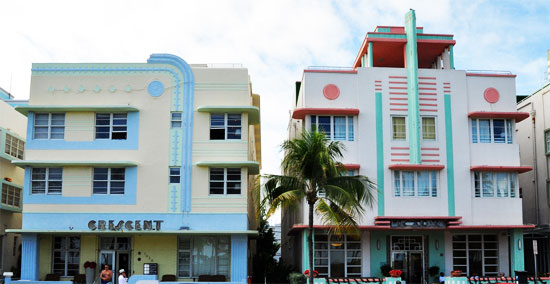Art Deco
Contents |
[edit] Introduction
Art Deco is a modernist architectural style that flourished in the mid-1920s through to the early-1930s. As well as having a significant influence on architecture, it also extended to fashion, art, sculpture, jewellery and furniture. It is characterised by its distinctive sharp-edges and stylised, geometric, decorative details.
Despite examples being evident in Europe and South America, Art Deco is seen as being synonymous with the American architecture of the time, being the first movement to break from the preceding Revival styles and embodying the ideas of the modern age.
Art Deco first came to public attention in 1922 when Finnish architect Eliel Saarinen entered a design competition for the Chicago Tribune Headquarters. Although it didn’t win, the style was widely publicised as being new and exciting.
This view became widespread after the 1925 Exposition Internationale des Art Decoratifs in Paris, a showcase for innovative new design ideas. The style focused on applied decoration and the embellishment of buildings with hard-edged, low-relief designs, as well as geometric shapes such as chevrons and ziggurats, inspired by Native American artwork as well as Egyptian, Babylonian and Assyrian archaeology.
However, it provoked criticism from proponents of modernism such as the Bauhaus movement and Le Corbusier, who viewed Art Deco as vulgar escapism that followed the whims of fashion rather than being rooted in functional realism.
Nonetheless, Art Deco began to grow in popularity and became a commonly adopted style for buildings such as theatres, cinemas, commercial buildings, government buildings, apartments, industrial complexes, and the the emerging building form of the age - the skyscraper.
[edit] Design characteristics
The main characteristics of Art Deco architecture are its sleek, linear, often rectangular geometric forms, arranged and broken up by curved ornamental elements. A series of set-backs creating a stepped outline help create the monolithic appearance of typical of Art Deco façades.
Building materials included; stucco, concrete block, glazed brick, smooth-faced stone, and Terracotta. Steel and aluminium were also commonly used together with decorative opaque glazing.
While some buildings featured hand-crafted elements, others made do with repetitive machine-made decorations that were less expensive. Such details could incorporate artistic or exotic motifs according to the function of the building or the preferences of the architect.
Flat roofs were often adorned with parapets, spires, or tower-like constructions to accentuate a corner or entrance, and decorative chimneys were also commonly added.
Windows were often arranged in continuous horizontal bands of glass to maintain a streamlined appearance and were frequently square or round openings with embossed spandrel panels placed below them. Decorative glass or glass blocks were used for wall openings as a means of maximising natural light and providing a contrast between solid and void forms.
Elaborate pilasters and pediments were used to decorate doorways, and the surrounds of doors were sometimes decorated with convex reeding or concave fluting.
Art Deco projects often produced dynamic collaborations between architects, painters, sculptors, and designers.
[edit] Notable buildings
Perhaps the environment most commonly associated with the Art Deco style is Old Miami Beach, Florida which boasts around 800 such structures.
Some other well-known examples of the Art Deco style are:
- Senate House, London
- Chrysler Building, New York
- Empire State Building, New York
- The Carlyle, Miami
- Chicago Board of Trade Building , Chicago
- Fisher Building, Detroit
- Los Angeles City Hall, Los Angeles
- Mossehaus, Berlin
- Centre for Fine Arts, Brussels
- Rex Theatre, Athens
- Palais de Tokyo, Paris
[edit] Related articles on Designing Buildings Wiki
- Aesthetic movement.
- Architectural styles.
- Art Deco Britain: buildings of the interwar years.
- Art Moderne.
- Art Nouveau.
- Arts and craft movement.
- Baroque architecture.
- Bauhaus.
- Beaux Arts style.
- Chicago school of architecture.
- Classical orders in architecture.
- Classical Revival style.
- Concept architectural design.
- Constructivist architecture.
- Deconstructivism.
- Empire State Building.
- English architectural stylistic periods.
- Futurist architecture.
- International Style.
- Italian Renaissance revival style.
- Metabolism.
- Mimetic architecture.
- Modernist architecture.
- Mosaic.
- Polite architecture.
- PWA Moderne.
- Rococo.
- Skyscraper.
- Spanish Colonial revival style.
- The history of fabric structures.
- Tudor revival style.
- Vernacular architecture.
[edit] External references
- PHMC - Art Deco
- Wentworth Studio
Featured articles and news
Gregor Harvie argues that AI is state-sanctioned theft of IP.
Heat pumps, vehicle chargers and heating appliances must be sold with smart functionality.
Experimental AI housing target help for councils
Experimental AI could help councils meet housing targets by digitising records.
New-style degrees set for reformed ARB accreditation
Following the ARB Tomorrow's Architects competency outcomes for Architects.
BSRIA Occupant Wellbeing survey BOW
Occupant satisfaction and wellbeing tool inc. physical environment, indoor facilities, functionality and accessibility.
Preserving, waterproofing and decorating buildings.
Many resources for visitors aswell as new features for members.
Using technology to empower communities
The Community data platform; capturing the DNA of a place and fostering participation, for better design.
Heat pump and wind turbine sound calculations for PDRs
MCS publish updated sound calculation standards for permitted development installations.
Homes England creates largest housing-led site in the North
Successful, 34 hectare land acquisition with the residential allocation now completed.
Scottish apprenticeship training proposals
General support although better accountability and transparency is sought.
The history of building regulations
A story of belated action in response to crisis.
Moisture, fire safety and emerging trends in living walls
How wet is your wall?
Current policy explained and newly published consultation by the UK and Welsh Governments.
British architecture 1919–39. Book review.
Conservation of listed prefabs in Moseley.
Energy industry calls for urgent reform.
























